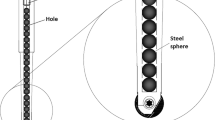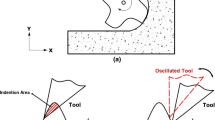Different designs of damping cutting tools intended to assure the stability of the cutting process and high quality of surface treatment are proposed. Theoretical and experimental studies of models of a cutting tool together with a determination of the microscopic irregularities of the worked surface are performed.
Similar content being viewed by others
Avoid common mistakes on your manuscript.
The widespread use of cutting processes in industry and the drawbacks of existing methods of compensation of vibrations of the tool have made it necessary to find more effective methods of protecting the tool against vibrations. One method involves improving the design of the tool.
We would like to review some of the damping cutting tools which we have previously developed.
One design of a cutting tool utilizes a cutting plate (with its attachment point in a holder with a sample) and an insert made of a material possessing the capacity to realize intensive damping. The sample is distributed uniformly along the perimeter of the end of the holder along the length of its endface until it reaches a projecting part with a cutting plate. The end of the holder with the sample is arranged in the form of a all-metal rectangular parallelepiped sleeve with identical gaps at its base and along the walls, the gaps being filled with the same material as the damping insert. The holder is mounted so that it cannot come into contact with the walls [1, 2].
Through the use of such a damping cutting tool, the stability of the cutting process may be increased and, consequently, the quality of the treatment as well.
However, a number of drawbacks were found in the course of fabrication and testing of a prototype of the cutting tool.
1. Cavities may form, especially near the base of the sleeve, if the gaps are filled with the same material as the insert, since it is difficult to assure uniform distribution of the material in the gaps, hence contact of the holder with the sleeve is possible and, consequently, a decrease in the stability of the cutting process as a consequence of ineffective damping of the resulting vibrations as well.
2. It is difficult to assemble the cutting tool due to the complexity of the positioning of the end of the holder with the sample in the sleeve while maintaining identical gaps in its base and on the walls.
The next version of the cutting tool was developed to eliminate these drawbacks (Fig. 1; section A–A corresponds to the cutting tool as assembled, section B–B to the cutting tool in the course of processing an article).
Order of treatment of structural material by a damping cutting tool. A sleeve assembled from the lower and upper half-sleeves 4 and 5 without adjusting set screws 7 is secured in the tool holder (not shown in Fig. 1). A holder 3 with sample is mounted inside the sleeve in an insert 6 made of a material with high damping properties. A cutting plate 1 is mounted at the other end of the holder in a rigidly fixed mechanism 2.
As the cutting plate interacts with the article which is being processed, the insert 6 separates the holder 3 from the metallic sleeve secured in the tool holder, which prevents the formation of cavities in the material of the insert 6 that cannot be inspected as well as contact of the metallic parts of the holder with the sleeve.
Such a structural design produces an increase in the stability of the cutting process and reduces the time it takes to assemble the cutting tool (maintenance of identical gaps is assured by means of adjusting set screws). A claim for the proposed invention (No. 2015103203, February 3, 2015) has been granted.
A theoretical analysis of the effect of vibrations on the cutting process created by a damping cutting tool has been carried out with the use of a mathematical model. On the basis of the arrangement in which the elastic elements are mounted in the cutting tool, we obtain six independent equations for the individual natural vibrations:
where a is a coefficient; δ = mω2; ω, angular frequency; m, mass of cutting tool; ξ x , ξ y , and ξ z , greatest amplitude values of displacements of center of mass of cutting tool in the direction of the coordinate axes; φ x , φ y , and φ z , greatest amplitude values of angular displacements of center of mass of cutting tool relative to coordinate axes; and \( {\uprho}_x^2={I}_x/m,{\uprho}_y^2={I}_y/m \), and \( {\uprho}_z^2={I}_z/m \), squares of radii of moments of inertia.
If the displacements ξ x , ξ y , and ξ z along the coordinate axes and the torsional vibrations φ x , φ y , and φ z about the coordinate axes are not equal to zero, then, in view of the fact that δ = mω2, by substituting the coefficients a with identical subscripts into the equation, we obtain
where P x , P y , P z and M x , M y , M z are the greatest amplitude values of the elastic forces and their moments.
The frequencies of the characteristic forward vibrations of the system along the coordinate axes OX, OY, OZ are, correspondingly,
We determine the natural frequencies of the rotational torsional vibrations relative to the axes OX, OY, OZ from the following conditions:
where k ix , k iy , and k iz are the elastic stiffnesses of the ith element in the direction of the axes OX, OY, OZ.
We determine the stiffness coefficients of the vibration dampers along the coordinate axes OX, OY, OZ from the equations
Substituting the values x i , y i , and z i and the stiffnesses from Eq. (3) into Eqs. (1) and (2), we are then able to determine the frequencies of the linear and torsional vibrations (sec−1):
The frequency of the natural vibrations, Hz, ν = ω i /(2π), i = 1, 2, ..., 6.
The frequency of the forced vibrations, sec−1, Ω = πn r /30.
The frequency of the disturbances, Hz, F = Ω/(2π) = n r /60.
The gain factor of the vibration forces μ is equal to the ratio of the force P transmitted to the cutting tool, to the excited force: P v : μ = P/P v .
We express the gain factor of the vibration loads based on the coefficient of damping ψ of the vibrations by the vibration damper:
The greatest efficiency of vibration insulation is observed where the natural frequency ω is one-half the frequency Ω. The greater is the ratio Ω/ω, greater is the effect of vibration insulation and vibration damping. With Shore hardness of the instrumental material in the range 35–75, the coefficient of damping of the vibrations and the vibration isolation ψ = 0.15–0.25.
Once vibrations have been transmitted to the cutting tool, the effect of vibration isolation produced by the instrumental material is found beyond the resonance region, amounting to 30 to 70% that observed with an ordinary cutting tool (without a damping element).
A prototype of the cutting tool was fabricated under the conditions of Kurskaviaavtomatika company, tests of standard and modified constructions in different regimes of working a shaft were conducted, the roughness parameters of the worked surface were determined, and the values of the natural freq
uencies of the vibrations of a lathe tool were established. A testing unit (Fig. 2), comprising a lathe tool, personal computer, E14-440 general-purpose module, and TYPKD 35 vibration sensor (attached to the test object a female screw or melted wax) was developed for this purpose.
Verification of the serviceability of the complex was performed by turning a shaft of steel 40X by standard and damping cutting tools with plates of solid alloy in the following cutting regimes: v = 20–90 m/min; S = 0.05–0.15 mm/rev; and t = 0.05–0.25 mm.
The double amplitude (range of vibrations) and the vibratory acceleration (vibratory displacement) , which in vibratory diagnostics is measured (where there is wide-band vibration present) in the range of vibrations 100–10000 Hz of lathe turning tools in the course of working, was determined for the purpose of quantitative estimation of vibration. The amplitude of the vibrations of a damping cutting tool is 15–20% less than the amplitude of the vibrations of a standard cutting tool (Fig. 3). An analogous result is obtained in measurements of vibratory acceleration.
Graphs illustrating the dependences of the vibratory acceleration and roughness parameter of a worked surface Ra on the cutting regimes were constructed from the test data (Figs. 4, 5) [3].
Conclusions
1. An increase in the quality of a worked surface and a 20–40% decrease in the roughness parameter Ra are observed in turning by a damping cutting tool.
2. The vibration indicators, expressed in terms of the codes of an analog-to-digital converter, and the vibratory acceleration in tests of the new design of a cutting tool were reduced on average by 30% by comparison with a standard cutting tool.
Thus, through the use of the proposed damping cutting tool the reliability of a stable cutting process and the working quality may both be increased as a result of damping of the vibrations and impact loads that arise in the cutting process.
References
S. G. Novikov, V. V. Malihin, E. A. Kudryashov, et al., “Increasing the stability of the turning process by means of a damping cutting tool,” Izv. Yugo-Zad. Gos. Univ., No. 3 (36), 122–125 (2011).
V. V. Malihin, S. G. Novikov, and F. V. Novikov, “Cutting tool with damping properties for numerically controlled machine tools,” Visn. Kharkiv. Nats. Tekhn. Univ. Silsk. Gos.: Tekhn. Nauki, Iss. 118, Tekhn. Servis APK, Tekhn. Tekhnol. Silsk. Gos. Mashinobud., Kharkiv (2011), pp. 147–150.
V. V. Malihin, Ye. I. Yatsun, and S. G. Novikov, “Increasing the operational characteristics of damping cutting tools,” Izv. Yugo-Zad. Gos. Univ. Ser. Tekhn. Tekhnol., No. 2, 43–46 (2012).
Patent No. 2370346 RF, “Instrumental mandrel and method of fabrication,” publ. 2010.
Author information
Authors and Affiliations
Corresponding author
Additional information
Translated from Khimicheskoe i Neftegazovoe Mashinostroenie, No.11, pp. 25–27, November, 2016.
Rights and permissions
About this article
Cite this article
Malyhin, V.V., Yatsun, E.I., Seleznev, Y.N. et al. Development of Designs of Damping Cutting Tools. Chem Petrol Eng 52, 763–768 (2017). https://doi.org/10.1007/s10556-017-0267-0
Published:
Issue Date:
DOI: https://doi.org/10.1007/s10556-017-0267-0









